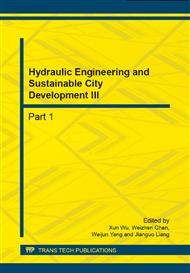p.53
p.58
p.65
p.70
p.75
p.80
p.84
p.88
p.92
Optimal Allocation of Water Resources Based on Multi-Objective Particle Swarm Algorithm and Information Entropy
Abstract:
Water allocation is a very complex problem, involving social, economic, environmental, and political factors. Consequently, it is a multi-objective decision-making problem. This paper presents a multi-objective model for the optimal allocation on multisource water for multiuser under sufficiently considering the harmonious development among economy, society and environment. A multi-objective particle swarm optimization (MOPSO) algorithm is employed to generate a set of Pareto-optimal solutions. At the same time, to facilitate easy implementation for the water allocation operator, information entropy theory is adopted to sort the decision results according to the magnitude of the superiority degrees. As a case study the proposed approach has been applied to the reasonable allocation of water supply and demand in the water-receiving areas of the South-to-North Water Transfer Project in China, in which the maximal benefit of economy, society and environment was regarded as the multi-objectives. The results show that the proposed approach is able to offer the quantifiable benefits or costs among different objectives for the water managers, and is highly professional in making decisions for allocating water among use sectors and different areas.
Info:
Periodical:
Pages:
75-79
Citation:
Online since:
September 2014
Authors:
Price:
Сopyright:
© 2014 Trans Tech Publications Ltd. All Rights Reserved
Share:
Citation:


